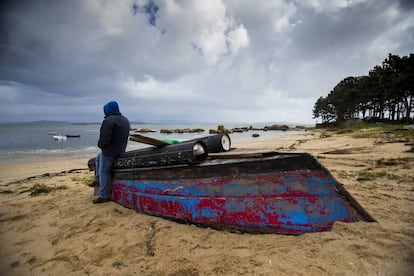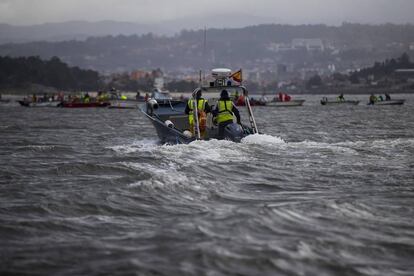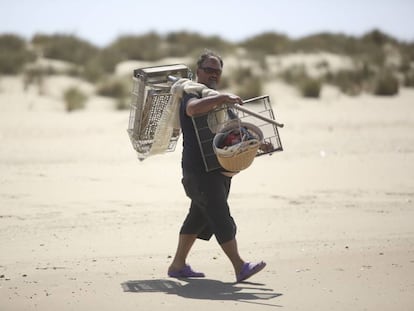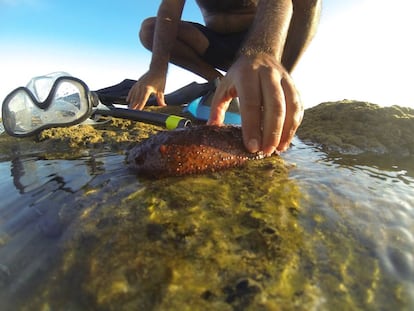The shellfish mafia on Galicia’s coasts
Groups of poachers are shifting tons of illegal seafood every year, selling what they harvest to restaurants and fish markets

Life is tough in Galicia. It’s hard to make a living from an over-fished sea and the boat-building industry no longer provides locals with jobs. Through sheer necessity, alternatives are sought and one of the most lucrative is proving to be the illegal harvesting of crustaceans along the region’s treacherous coastline.
“I paid for the beach house I have with the money I made from razor clams,” says one of Galicia’s poaching success stories, who we’ll call Ramón. He has, he explains, gathered as many as 140 kilos of clams in a single night. “I started poaching shellfish when I was eight,” he reveals from the terrace of a bar in las Rías Baixas, where he has lived all his life. “As the son of a seaman, I was put to work at an early age.”
Apart from clams, he dives for scallops and crabs. “While I go under, there’s a lookout car and another person waiting above water. We usually gather 60 kilos in around four or five hours. I’ve managed as much as six hours diving without oxygen.”
In the mid-90s, poaching earned Ramón millions of pesetas. Not only did he purchase his beach house, he also bought an apartment in A Coruña and another in Santiago de Compostela. “The trick is to keep an eye out,” he says. “I’m forever looking in the rear-view mirror and if I see the same car three times, I’m out of there. I usually dive at night, around 3am. There are four or five of us. We’re organized.”
So organized that the Civil Guard and the regional government’s coastguards have pulled resources to combat what is being referred to as Galicia’s “other mafia,” a reference to the drug gangs that have long operated in the area.
No different from smugglers
According to data from the Galician Sea Ministry, 73,140kg of illegal seafood was seized in 2016. Last year, the figure rose to 175,074kg. “There’s no doubt we have a problem in Galicia, ” says Lino Sexto, Deputy Director of the Galician Coastguard. “But it’s really not dramatic. It’s a problem that goes way back and one that is very hard to tackle, but things are improving.”
Poaching seafood was only made illegal in 2015 and now carries a prison sentence, although no one has yet been jailed for the offense. “Paying the fine is worthwhile and there are those who feel untouchable,” says Lino.
In Muxia, a fishing town on Galicia’s Costa da Morte, a retired fisherman called Moncho de Pesco explains that the poachers use boats with powerful motors and have lookouts posted in strategic positions both at land and sea, sometimes armed with sticks. When they dive under, there’s little that escapes them.
“They strip the rocks under the sea, taking 50% of the product,” he says. “They can make €6,000 in a night and they’re out a third of the year. Go figure. They’re no different from smugglers.”
Suso is a watchman from the San Telmo fishermen’s guild in Pontevedra. The guilds in Galicia are obliged look out for poachers. They are meant to take it in turns, but the practice is not always observed and, where it is, the watchmen have no way of dealing with the situation. “It’s a mafia. Write that down. MAFIA,” shouts Suso as he unties his boat at the Campelo port. “They burned my car a month ago and broke my glasses. I’ll tell you something: they’re worse than the narcos!”
Not all the poachers are making a mint, however. Indeed, there are many who are barely scraping a living from a couple of kilos of crab. A small time poacher who calls himself Javier explains: “I do it to survive. I’m not doing anything wrong, just working. What have the coastguards to say to me? There are only a few violent poachers. Most of us are decent folk who only want to put food on the table for our families.”
These groups are organized, they earn a lot of money and they don’t hide what they do. They drive big cars and powerful motorbikes, and buy apartments
The organized groups gather the more profitable clams, scallops and razor clams and are shifting tons not kilos. “These groups are organized, they earn a lot of money and they don’t hide what they do,” says one fisherman. “They drive big cars and powerful motorbikes and buy apartments – as if they were narcos. In fact, some are. They run the seafood alongside the tobacco and drugs. Look at the Os Fanchos clan. They dabble in everything, though there’s no need. The most powerful groups of poachers make more money than the smugglers.”
“Most people know who they are,” says Lino Sexto. “Poaching is tolerated and accepted in Galicia. These folk are not hiding it. On the contrary, they like showing off.”
Four days ago, storms left a number of Fisterra beaches covered with scallops and families wasted no time in gathering them up. “Even the mayor said it was normal. And he’s a biologist! There’s no awareness of the damage caused by poaching,” says Lino.
In Muxía, Moncho says he knows exactly who the poachers are. “So what am I going to do? Fight them? That’s not my job,” he says. Meanwhile, in A Coruña, it is normal to see the poachers selling their produce on the streets – produce they’ll be rid of it in a matter of hours.
The war
“We had a lot of trouble in the O Burgo estuary [close to A Coruña] a few years back,” says Enrique Rodríguez from the coastguard. “A number of families gathered clams there and used their children as shields. I got a cut on my eyebrow from a punch and some time ago they exchanged fire with the Civil Guard.”

In the port of Marín, close to Pontevedra, Enrique invites us to board the Irmáns García Nodal, a government vessel whose mission is to combat poaching. “The service has eight operational bases along the coast,” he explains. “We have informants and then they inform on each other as well – like, these guys are going out tonight, that one has no license.”
But the information flies back and forth in both directions. “I know the exact time and day that the coastguards are going to be out,” says Ramón, smiling. “We have our sources.” And if the coastguard does appear, it makes no difference. The poachers own the most powerful boats on the estuary.
The best restaurants in A Coruña
“We have to look at the commercial outlets,” says Lino Sexto. “That’s the key.” Ramón, for example, is selling to the best restaurants in A Coruña and Santiago. “If I told you names, you wouldn’t believe it,” he says. “I give them what they ask for, we do the invoice in the name of a legal fisherman and that’s it.”
Besides restaurants, the merchandise is offloaded in fish markets and at catering companies, water treatment plants and cultivating laboratories. “Many poachers carry a fisherman’s license and, if they don’t, then the group has one,” says Ramón. “That way they can sell or store the produce all over the place. Ha, the day they investigate the Galician sewage plants!”
When Ramón is done with his revelations, he points out an empty fish tank. “Do you know why this is empty?” he asks and a passing waiter replies, “Because you haven’t brought us anything for a month!” Everyone laughs.
The heart of the mafia
In a fishermen’s guild on Death Coast, no one wants to talk about poaching. After a dozen refusals, one member sidles up and says, “You know why no one wants to speak? Because most Galician fishermen are also poachers.”
“Most?” says Ramón. “I would say 100%. It’s the real mafia.”
This is what’s called “insider poaching.” “It accounts for 95% of the problem,” says Lino Sexto. “They’re having serious trouble with the size of the catch and the seasons.”
The fisherman from the Death Coast guild adds: “Here, everyone has something up their sleeve. They do their own thing. There is no commitment, or solidarity. It’s typical of Galicia. No one reports anyone and everyone tolerates everything because no one is clean.”
And while Lino points out that there is no real awareness of the problem, Ramón says: “Nothing effective has ever been done to raise awareness. If things had really been done properly – if they trained and educated the seafood harvesters – this could be solved in two days.”
English version by Heather Galloway.
Tu suscripción se está usando en otro dispositivo
¿Quieres añadir otro usuario a tu suscripción?
Si continúas leyendo en este dispositivo, no se podrá leer en el otro.
FlechaTu suscripción se está usando en otro dispositivo y solo puedes acceder a EL PAÍS desde un dispositivo a la vez.
Si quieres compartir tu cuenta, cambia tu suscripción a la modalidad Premium, así podrás añadir otro usuario. Cada uno accederá con su propia cuenta de email, lo que os permitirá personalizar vuestra experiencia en EL PAÍS.
¿Tienes una suscripción de empresa? Accede aquí para contratar más cuentas.
En el caso de no saber quién está usando tu cuenta, te recomendamos cambiar tu contraseña aquí.
Si decides continuar compartiendo tu cuenta, este mensaje se mostrará en tu dispositivo y en el de la otra persona que está usando tu cuenta de forma indefinida, afectando a tu experiencia de lectura. Puedes consultar aquí los términos y condiciones de la suscripción digital.
More information
Archived In
Últimas noticias
Aquilino Gonell, former Capitol sergeant: ‘If it hadn’t been for the police, the US would be a dictatorship’
A hybrid building: Soccer pitch, housing, and a shopping mall
Europe urges Trump to respect Greenland following annexation threats
Science seeks keys to human longevity in the genetic mixing of Brazilian supercentenarians
Most viewed
- Alain Aspect, Nobel laureate in physics: ‘Einstein was so smart that he would have had to recognize quantum entanglement’
- Mexico’s missing people crisis casts a shadow over World Cup venue
- Why oil has been at the center of Venezuela-US conflicts for decades
- Alvin Hellerstein, a 92-year-old judge appointed by Bill Clinton, to preside over Maduro’s trial in New York
- Cuba confirms death of 32 of its citizens in the US attack against Venezuela










































